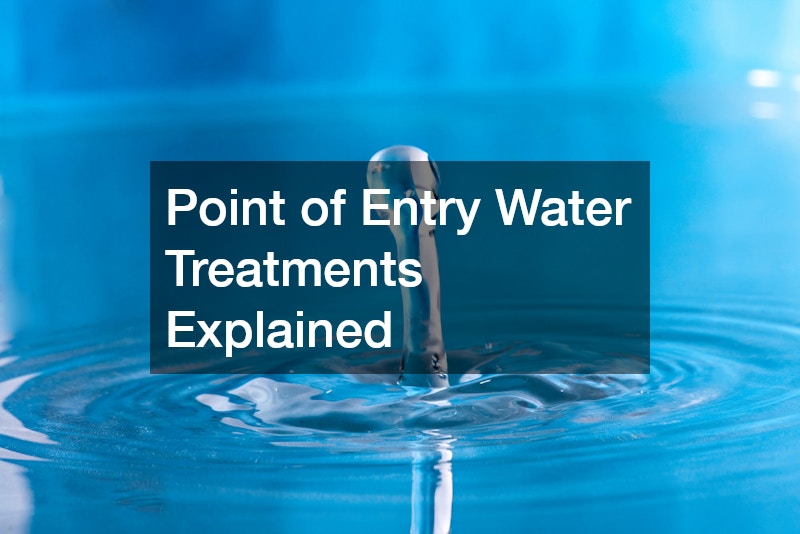
Point-of-entry (POE) water treatment systems are installed at the main water line, where water first enters a home or building. This type of system treats all the water that is distributed throughout the building, unlike point-of-use water treatment systems which are designed to treat water at a single tap or outlet. POE systems provide comprehensive water treatment solutions, ensuring that all water, whether used for drinking, bathing, or cleaning, is treated.
The use of POE water treatment is ideal for addressing issues related to hard water, sediment, chlorine, or other contaminants that may affect the quality of water in an entire home. Given that the system treats water at the point it enters the home, all faucets, appliances, and showers benefit from the filtered water.
Homeowners often choose POE systems to secure the longevity and efficiency of household appliances and improve water quality throughout their entire household infrastructure.
In terms of installation, POE systems require professional setup as they need to be connected to the primary water line. Once installed, however, these systems offer an uncomplicated way to address water quality issues throughout a home or building. They are particularly effective in areas where municipal water supplies may include higher levels of chlorine or other potential contaminants.
Key Components of POE Water Treatment Systems
Point-of-entry (POE) water treatment systems systems typically consist of several key components, including filters for sediment, activated carbon, and sometimes UV light sterilization. Sediment filters are often the first line of defense, trapping larger particles such as sand, silt, and rust that may be present in water supplies. This primary filtration step helps protect downstream components of the whole home system from blockages or damage.
Activated carbon filters are commonly used in POE systems to remove chlorine, odors, and volatile organic compounds (VOCs) from water. The porous nature of activated carbon allows for the absorption of these chemical impurities, ensuring that the water’s taste, smell, and safety are greatly improved. In some systems, additional components like ion exchange resin could be used to specifically address issues of water hardness by reducing calcium and magnesium content.
Advanced POE water treatment systems may integrate ultraviolet (UV) light sterilization to eliminate pathogens such as bacteria and viruses. This sterilization process is highly effective and works instantly as water flows through the system. These components together provide a robust and comprehensive water treatment solution that ensures water entering a home is clean, safe, and palatable.
Benefits of Using Point of Entry Water Treatment Systems
A significant benefit of POE water treatment systems is their ability to improve water quality at all points throughout a home. Because they treat the water as it enters, all outlets in a building will deliver treated water, making it healthier and safer for all uses. This is particularly valuable in older houses with outdated plumbing where contaminants might leach into the water supply.
The all-encompassing nature of POE systems also translates to extended longevity and enhanced performance of household appliances. Water heaters, dishwashers, and washing machines that use softened and filtered water tend to suffer less from scale buildup, which enhances their efficiency and operational lifespan. Using a POE system could lead to reduced maintenance costs and potential savings on appliance replacement in the long run.
Moreover, many homeowners value the improvement in personal comfort and well-being as a result of installing a POE system. Skin irritation caused by minerals or chlorine in tap water can be reduced, and the improved taste and odor of water can encourage higher water consumption, supporting overall health. These systems offer a comprehensive way to secure peace of mind by ensuring access to high-quality water at every tap.
Considerations for Choosing a POE System
When selecting a POE water treatment system, it is critical to assess the specific water quality issues present in your home. This involves conducting a water test to identify contaminants such as iron, chlorine, or hard water minerals. Understanding the unique challenges you face will guide you in selecting the correct type of filtration media to address those needs effectively.
Another consideration is the upfront and ongoing cost associated with a POE system. While these systems can be more expensive to purchase and install than their point-of-use counterparts, they often require less frequent maintenance due to their robust design and large capacity filters. It is important to balance initial investment with long-term savings in maintenance and improved appliance performance.
Finally, prospective buyers should consider the space and plumbing requirements necessary for a successful installation. POE systems generally require ample space near the point of water entry and might necessitate upgrades to existing plumbing. Consulting with a professional can ensure that you choose the right system and installation strategy to meet your household’s water quality needs securely and efficiently.
.





